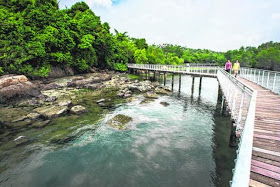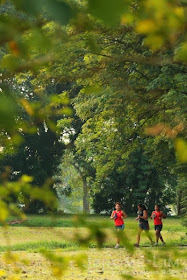My Paper, Wednesday, January 08, 2014, Page A14, Lifestyle, Journeys
From http://epaper.mypaper.sg/emnd/fvxen/fvxp/fvxpress.php?param=2014-01-08
Source Website: http://mypaper.sg/lifestyle/untouched-singapores-concrete-20140108
By SANJAY SURANA, The New York Times, mypaper, myp@sph.com.sg, Published on Jan 08, 2014
From http://epaper.mypaper.sg/emnd/fvxen/fvxp/fvxpress.php?param=2014-01-08
Source Website: http://mypaper.sg/lifestyle/untouched-singapores-concrete-20140108
By SANJAY SURANA, The New York Times, mypaper, myp@sph.com.sg, Published on Jan 08, 2014
PHOTO: AN OASIS OF NATURE: A boardwalk on Pulau Ubin, a 10 sq km island near Singapore that the writer visited. Today, fewer than 50 Singaporeans live here, along with animals like red junglefowl, scaly-breasted munias, wild boars, Malayan water monitors and long-tailed macaques.
PHOTO: THE NEW YORK TIMES
https://blogger.googleusercontent.com/img/b/R29vZ2xl/AVvXsEgd1j0M0stGy9zDz1dr2PmCur4TIfhmiaXED_EPrkSmhk200UBMNHiPsWomZ_Leg7CjFT9g5h5Ni-n-rJhYtwLG2JM4f8-WV1TQqFaIdZtwdObdeLVMZeWDY6nyHkzTKatf9vJA3kM47Tw/s1600/MY_20140108_JOURNEYS08_P_87660-1.jpg
http://mypaper.sg/sites/default/files/styles/large/public/field/image/20140108/MY_20140108_JOURNEYS08_P_87660.jpg
http://mypaper.sg/lifestyle/untouched-singapores-concrete-20140108
PHOTO: THE NEW YORK TIMES
https://blogger.googleusercontent.com/img/b/R29vZ2xl/AVvXsEgd1j0M0stGy9zDz1dr2PmCur4TIfhmiaXED_EPrkSmhk200UBMNHiPsWomZ_Leg7CjFT9g5h5Ni-n-rJhYtwLG2JM4f8-WV1TQqFaIdZtwdObdeLVMZeWDY6nyHkzTKatf9vJA3kM47Tw/s1600/MY_20140108_JOURNEYS08_P_87660-1.jpg
http://mypaper.sg/sites/default/files/styles/large/public/field/image/20140108/MY_20140108_JOURNEYS08_P_87660.jpg
http://mypaper.sg/lifestyle/untouched-singapores-concrete-20140108
A visit to Pulau Ubin
AFTER cycling a half-mile along a soggy clay track that sliced through a corridor of rubber trees, tailed by an electric-crimson-coloured dragonfly, arches of bamboo creating a canopy, I emerged by a small, silty lake.
A dilapidated jetty reached out into the water, a mint-green fishing boat loosely tied to it; a splintery, whitewashed wooden sign nailed to a sea-grape tree announced: "Cold Drinks."
But there wasn't a soul in sight, only a dozing dog that roused itself, momentarily, at my presence. Such are the simple, solitary pleasures of Pulau Ubin.
This 10 sq km island, formerly thrumming with granite quarries - Pulau Ubin is Malay for Granite Island - is only a 10-minute boat ride from its motherland, Singapore, but the gulf between the two couldn't be more pronounced.
While the Lion City, which marked its 48th year of independence in August, has grown rapidly in the last five decades - outward by more than 20 per cent (through land reclamation), upward (via the endless construction of office and condo towers), financially (it's the world's third-richest country in gross-domestic-product terms) and in crowdedness (it has the second-highest country-population density after Monaco) - Pulau Ubin, which has no electricity or running water, is like a land that time forgot, stuck in the 1960s, when newly independent Singapore was a scattering of low-slung, stilt-housed villages. And for that, many Singaporeans are thankful.
According to folklore, hilly Ubin was formed when an elephant, a pig and a frog challenged one another to cross the waters to Johor, across the Straits of Johor. Whichever failed - and all three did - was turned to stone.
The pig and elephant became Pulau Ubin, and the frog, Pulau Sekudu (Frog Island), visible off Ubin's southern coast.
The stone, granite, was the island's sole industry from the 1800s up to 1999, when the last quarry closed, and, in its heyday, thousands called Ubin home. Today, fewer than 50 Singaporeans live here, and nature is very much in control, reason for the Government to categorise Ubin as "open space and reserve land" in 2001.
Compared with the glass-clad skyscrapers, air-conditioned shopping malls and rush-hour-traffic-choked roadways of Singapore, Pulau Ubin is a grounding antidote to urban existence. This quality is its attraction, judging by the arrivals - about 2,000 each weekend, and a handful of French families, British backpackers and Singaporean youth looking to temporarily change scenery on weekdays - who come to experience a long-forgotten Singapore.
From Ubin's jetty - reached by bare-bones wooden vessels called bumboats - and tiny main village, a few paved roads fan out to coastal campsites, dirt paths, lotus ponds or beautiful wetlands.
The most striking constant is the lack of noise. Apart from the odd muted roar of a 777 landing in Singapore, sounds are limited to the crowing of red junglefowl, the chirps of scaly-breasted munias, straw-headed bulbuls, Oriental magpies and collared kingfishers, or the wind rattling candlenut, jambu bol and nipah-palm leaves.
Despite the unspoiled character of Pulau Ubin, there are ripples of concern among the holdout residents who doggedly champion the island's anachronistic lifestyle. Last January, the Government published a Population White Paper projecting that the city-state's populace could hit 6.9 million by 2030, requiring 65 sq km of additional land, possibly through developing "some of our reserve land".
Two months later, the island's householders received a letter from the Government's public-housing body raising the spectre of development. In July, the Government quashed any rumours, stating that there is no development plan for Pulau Ubin.
For now, Ubin residents believe that the island's primitive ways are safe, and there are reasons for optimism that green spaces will continue to be valued. Last year, Singapore unveiled its "50 Years of Greening"
campaign and, in April, Singapore announced its application to Unesco for World Heritage site status for the 154-year-old Botanic Gardens. On the day of my visit to Ubin, National Parks Board employees were diligently tagging birds to study their habitats and migratory patterns.
After the restlessness of Singapore, Pulau Ubin's gentle wilderness is a relief. I biked to Chek Jawa Wetlands on Ubin's south-east coast, a reserve that incorporates six types of ecosystem (including coral rubble, coastal forest and mangroves, all visible from a boardwalk). It is home to the piercingly vocal oriental pied hornbill, has a Tudor house for a visitors' centre, and a 21m-tall viewing tower that, once summited, cliches aside, will make a visitor feel like the king of the jungle.
Ubin's parallel universe soon feels normal. On the main island, shade comes courtesy of man-made walkways or the shadows of skyscrapers; here, the abundance of trees ensures shade is ubiquitous.
In Singapore, office workers are glued to smartphone screens; here, visitors quickly learn to look in all directions, with visual stimulation from a wild boar muscling through the forests to the side, or a Malayan water monitor slinking into the reeds by the roadside up ahead, or a troop of long-tailed macaques leaping from branch to branch overhead.
Ubin has Singapore's only off-road mountain-biking track, a circuit of gravel trails, rocky hills and flowering meadows.
And Puaka Hill, the island's highest point, provided a vista that I hope to never forget. Below, dark-blue water filled the abandoned Ubin Quarry, the surrounding forests giving it the appearance of a giant sapphire on a bed of emeralds.
Singapore's outline stretched across the horizon. That there was nobody with whom to share the view with was reward in itself.
By SANJAY SURANA, The New York Times, mypaper, myp@sph.com.sg, Published on Jan 08, 2014
PHOTO: The plans put forward by the HDB do show some sensitivity to what the place might once have been or represented, with the cemetery and the greenery it provided not completely forgotten.
Posted by Jerome Lim, The Long and Winding Road
https://blogger.googleusercontent.com/img/b/R29vZ2xl/AVvXsEjgPL_OvwuG_RWI7SBFwNcc-F0wJqabRiEUk3VL5PSLiGfmZJGmIAZDl3p4HxKknuqpNqLCsAWB9VliRaSJRmSYI3cqZ_lm_d5OGs9uD06pCEdd7vI4H0ddFIc27MItwRzer66ySlsP1mk/s1600/jeromelim-277a4568.jpg
http://thelongnwindingroad.files.wordpress.com/2013/11/jeromelim-277a4568.jpg?w=510&h=764
http://thelongnwindingroad.wordpress.com/tag/urbanisation/
Reference
Posted by Jerome Lim, The Long and Winding Road
https://blogger.googleusercontent.com/img/b/R29vZ2xl/AVvXsEjgPL_OvwuG_RWI7SBFwNcc-F0wJqabRiEUk3VL5PSLiGfmZJGmIAZDl3p4HxKknuqpNqLCsAWB9VliRaSJRmSYI3cqZ_lm_d5OGs9uD06pCEdd7vI4H0ddFIc27MItwRzer66ySlsP1mk/s1600/jeromelim-277a4568.jpg
http://thelongnwindingroad.files.wordpress.com/2013/11/jeromelim-277a4568.jpg?w=510&h=764
http://thelongnwindingroad.wordpress.com/tag/urbanisation/
Reference
- My Paper, Wednesday, January 08, 2014, Page A14, Lifestyle, Journeys
- http://epaper.mypaper.sg/emnd/fvxen/fvxp/fvxpress.php?param=2014-01-08
- http://mypaper.sg/lifestyle/untouched-singapores-concrete-20140108
- https://blogger.googleusercontent.com/img/b/R29vZ2xl/AVvXsEgd1j0M0stGy9zDz1dr2PmCur4TIfhmiaXED_EPrkSmhk200UBMNHiPsWomZ_Leg7CjFT9g5h5Ni-n-rJhYtwLG2JM4f8-WV1TQqFaIdZtwdObdeLVMZeWDY6nyHkzTKatf9vJA3kM47Tw/s1600/MY_20140108_JOURNEYS08_P_87660-1.jpg
- http://mypaper.sg/sites/default/files/styles/large/public/field/image/20140108/MY_20140108_JOURNEYS08_P_87660.jpg
- http://mypaper.sg/lifestyle/untouched-singapores-concrete-20140108
- https://blogger.googleusercontent.com/img/b/R29vZ2xl/AVvXsEjgPL_OvwuG_RWI7SBFwNcc-F0wJqabRiEUk3VL5PSLiGfmZJGmIAZDl3p4HxKknuqpNqLCsAWB9VliRaSJRmSYI3cqZ_lm_d5OGs9uD06pCEdd7vI4H0ddFIc27MItwRzer66ySlsP1mk/s1600/jeromelim-277a4568.jpg
- http://thelongnwindingroad.files.wordpress.com/2013/11/jeromelim-277a4568.jpg?w=510&h=764
- http://thelongnwindingroad.wordpress.com/tag/urbanisation/

